Narrative research: Access, methods and pathways to a stronger field
Successful narrative change projects require practitioners to know what strategies work. When to use them. Who their audience is. That takes research and data analysis, message testing and training. It means sharing what we learn with partners both old and new. It also means breaking down silos and pushing the capacity to test, analyze and report into the hands of frontline communities and people of color.
Last week, Narrative Initiative and Spitfire Strategies hosted a webinar to share findings from interviews and research conducted by Spitfire earlier this year. The Field Guide: Narrative Research Methodologies details the project and findings.
We were fortunate to share our findings with about 100 practitioners on the webinar. Here are highlights of the findings, including a look at the disparities in research access and what this project says about steps forward.
Key Findings
We conducted 18 in-depth interviews with in-house researchers at non-profits, staff at non-profits who outsource research, staff at academic and research organizations, and narrative research professionals. We sought to learn how they do narrative research now, what’s useful to them, what they’re learning, where gaps exist and how the field can do better.
Frontline groups/people of color lack access to research findings, tools and training
Narrative change work (we’re talking here about deeper narratives that move behavior changes across society, not a short-term political or marketing narrative) demands collaboration across organizations and disciplines.
Our conversations raised a concern that frontline groups have less access to research capabilities despite being closest to where messages are shaped and distributed. Interviewees called for sharing research, tools, data and insights. They pointed to equity and diversity disparities as a challenge to collaboration and success. Interviewees identified access to insights and tools as necessary to support more and higher impact collaboration across the field.
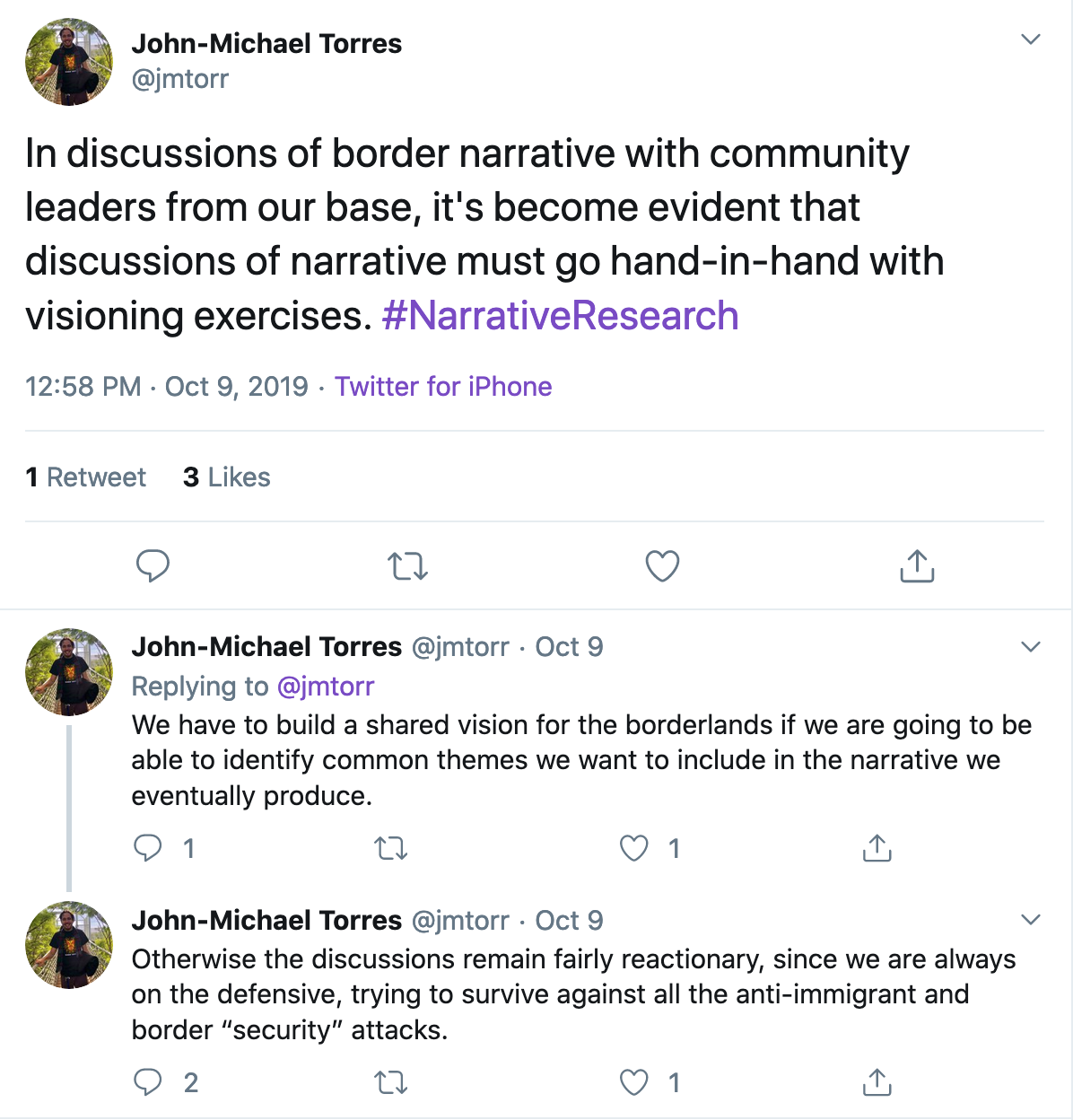
Tweet by John-Michael Torres on the value of collaboratively creating a narrative vision.
Emergent research methods offer sophisticated but unevenly distributed insights
We identified several emergent research methods. These methods respond to the complexity of identifying what shapes narrative. Emergent tools also track how narrative moves in an information rich world of social media, 24×7 news, and microtargeting.
- Big listening tools that find and track keyword data among social media, online news, online audio and video and more.
- Layered social and language analysis looks for patterns, network relationships and cause-effect in communications. While big listening identifies trends, layered analysis looks more deeply to find intention, influence and impact.
- Narrative analysis looks for metaphors, terms and subject-verb-object patterns. Narrative analysis patterns may reveal depth of narrative use and shift.
- Topos TalkBack is a proprietary messaging analysis approach that compares intent with people’s understanding and use of communications.
We also identified more standardized communications and messaging research methods that support and inform narrative work:
- Academic Literature Review
- Behavioral Science
- Cultural Models Research
- Field Testing
- Interviews
- Language Analysis
- Market and Political Research Standards (dial testing, polling and focus groups)
- Neuroscience
- Participatory Action Research
- Surveys
Interviewees identified discrepancies in access to all research methods. Training and capacity use the right research tools is uneven. Groups may misuse research (or avoid it altogether) when not knowing what methods to use, how to deploy research, how to interpret findings, and where to access support and more.
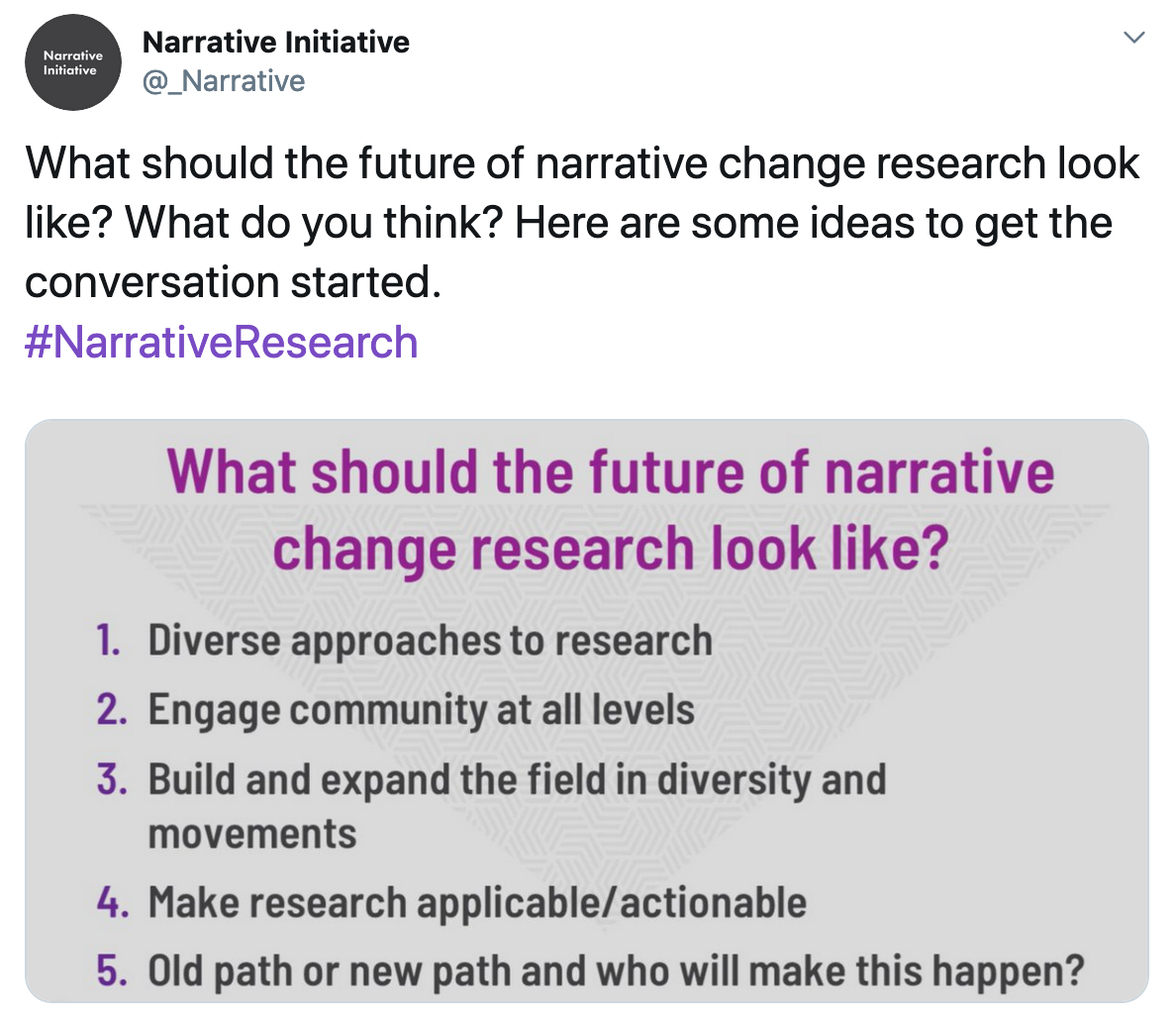
Tweet about the future of narrative research by Narrative Initiative.
Ten Pathways Forward
Access to research tools and findings is uneven. Emergent tools are advancing findings but they’re typically unavailable to much of the field, especially frontline and grassroots groups.
What do we do now? This is where researching narrative research methods gets into the field-building (or norming) phase. The field is looking for coherence, ethical standards, and consistently communicated information. Together, these are the stakes in the ground that map out the field, create expectations, and allow people to step in and work together.
We identified ten pathways that build capacity in organizations and scale the field. Each expands ability, access and reach. In combination, they serve as force multipliers that help narrative change practitioners better collaborate, access skills and use the right tools at the right time.
Do more education and capacity building – and expand access to narrative change research methods. This is especially critical for community activists and frontline groups.
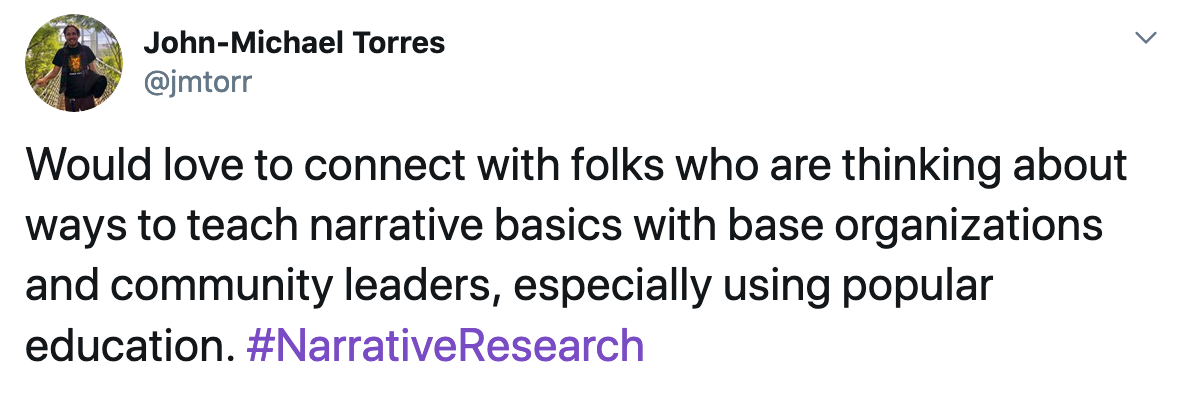
John-Michael Torres tweets about collaborating on narrative research.
Talk to people in the field. Don’t rely on polling and quantitative social media analytics gathered in the back office.
Focus on persuasion and action. Not just engagement. Building lists is relatively fast and easy. And of little use if you can’t go deep to change behavior. More persuasion research, please.
Embrace the role of culture change. Culture locks (and unlocks) the collective imagination. We need to see more, better, and more accessible research into how culture change works and how cultural narratives shift politics and policy.
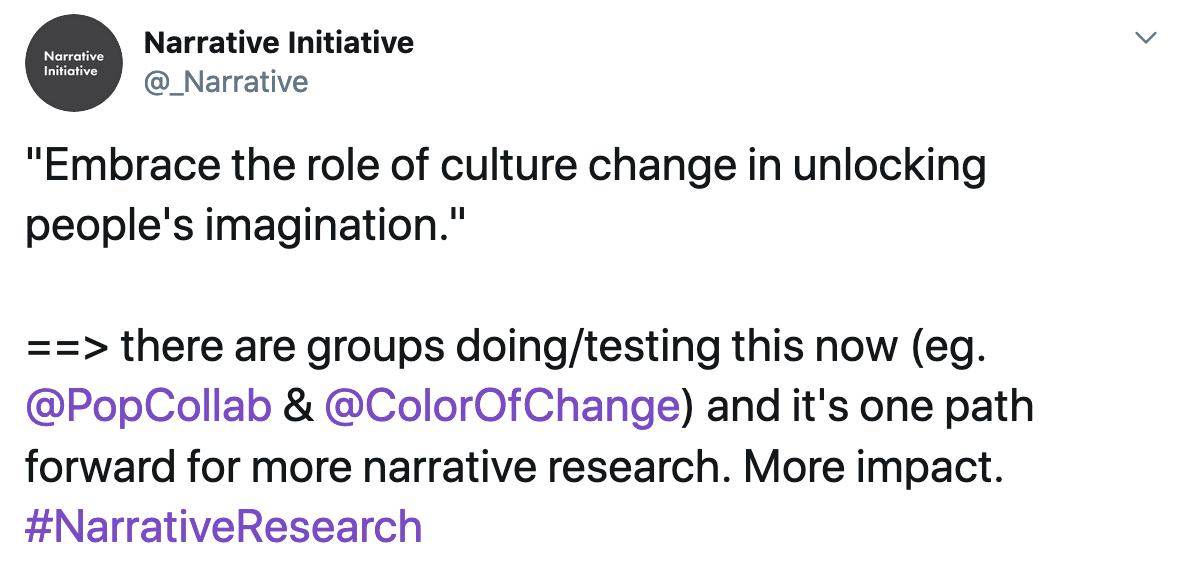
Narrative Initiative tweet about the need to do and share more research into the intersection of culture and narrative.
Do more research collaboration across social justice movements. Narrative change is long-term and multi-issue. For example, people consider many factors when acting (or choosing not to act) on economic inequality. Race, employment, and education are just a few issues that can’t conduct narrative research in isolation if we’re to shift deep economic narrative.
Improve equity and representation. Some interviewees told us that people of color face unique hurdles securing funding for narrative change research. One put it this way: “funders don’t trust black ingenuity.” This isn’t just about funders. People and groups working in the field can advocate for more equitable funding and diversified research.
Create ethical standards to help demonstrate coherence across the field. Polling, for example, is a widely used but seen as unreliable and a source of inequity when doing narrative research in frontline communities.
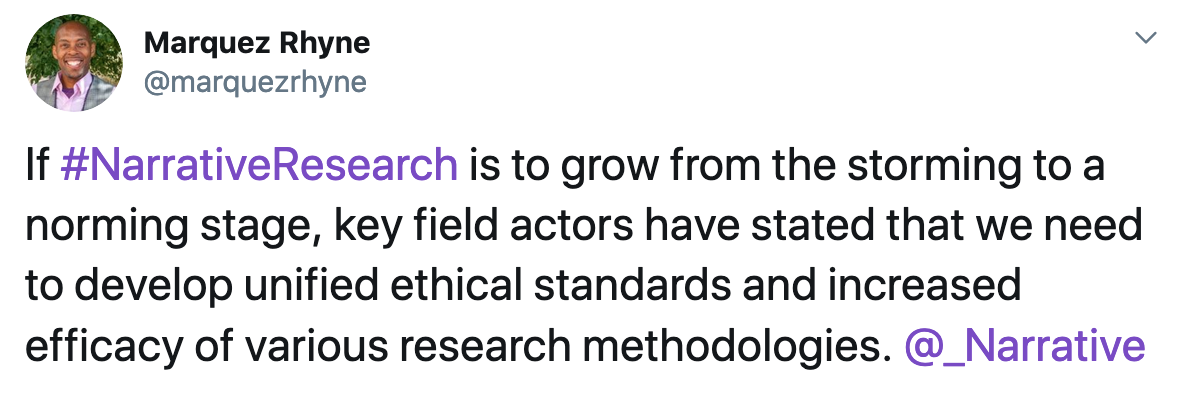
Márquez Rhyne, a lead on the narrative research project, on the value and role of ethical standards for research.
Advance research education and capacity building. Identify the people and groups who do research education and capacity building. Note the gaps. Support efforts to expand the number and reach of capacity builders.
Strengthen the capacity of organizations to do their own research. Narrative research often happens in academia, think tanks, or groups disconnected from practitioners. Doing narrative research in impacted communities, in real time, and making findings available could be a gamechanger.

Building the capacity of frontline groups to conduct and share narrative research could be a gamechanger. Tweet via Narrative Initiative.
Shift legacy funding patterns that result in unequal access, duplicative work, competition between groups, and disincentives to long-term research.
What’s Next
The choice of narrative research methodologies and insights gleaned from research have direct impacts on the efficacy of narrative change strategies. Research methods will continue to be limited until the field expands the capacity to perform and share research and puts research tools and training in the hands of more groups doing frontline work.
We look forward to taking the findings of this report to practitioners and other stakeholders in the field. These findings and ongoing conversations will help shape recommendations and outcomes that may benefit narrative change practice for years to come.


